Ruby-throated Hummingbird
(Archilochus colubris)
Conservation • Description • Habitat • Ecology • Distribution • Taxonomy
|
|
||||||||||||||
Description |
Ruby-throated Hummingbird is the smallest Breeding bird in the eastern United States and southeastern Canada. It is seldom seen but easily recognized because it is the only hummingbird that breeds in or migrates through Minnesota. It is 3″ to 3½″ in length and has a 3⅛″to 4¼″ wingspan. The male weighs about 3 grams, the female about 3.5 grams. The adult male has an iridescent green back and forehead, whitish underparts, gray or grayish-green sides and flanks, an iridescent ruby-red throat (gorget), and a black face and chin. The bill is slender, straight, and about ¾″ long. The tail is entirely dark and forked. The wings are nearly black. The adult female is larger. It has a grayish-white throat; a longer bill; a rounded to squared, shallowly forked tail; and white tips on the outer tail feathers. Juveniles resemble adult females. Young males and some older females have a few red feathers on the throat. |
Size |
3″ to 3½″ in length 3⅛″to 4¼″ wingspan |
Voice |
|
|
A soft buzzing of the wings. A loud "chick" or squeak. |
Similar Species |
Rufous Hummingbird (Selasphorus rufus) is the only other hummingbird found in Minnesota. It is a rare, accidental visitor, not a resident. The back of the male is entirely brownish-red (rufous), occasionally with some green markings, but rarely entirely green. The female has a white throat with red spots. |
Habitat |
Dense or open, mixed or deciduous woodlands; wetlands, savannas, orchards, gardens, wooded back yards. |
Ecology |
Migration |
In the spring, males arrive in late April or early May and establish a territory. Females arrive in early to mid-May. In the fall, adults males begin migrating in early August. Females follow soon afterward. They fly across the Gulf of Mexico or along the western coast of Mexico and spend the winter in Central or South America. |
Nesting |
The male performs a diving courtship display for any female that alights in its territory in the spring. After mating, the male has nothing more to do with the female or its offspring. The female selects a nest site usually near the end of a down-sloping branch. She builds an open, cup-shaped nest on top of the branch out of bud scales, binding it together with spider silk or pine resin, lining it with thistle or dandelion down, and decorating it with lichens or moss. The nest takes 6 to 10 days to build and is about 2″ in diameter when done. When the nest is completed the female lays 1 to 3 white, ½″ to 9 ⁄16″ long eggs. The eggs hatch in 12 to 14 days. The young leave the nest 18 to 22 days after hatching. |
Food |
Flower nectar, small insects and spiders, sweetened water from backyard feeders. Where available, they also feed from Yellow-bellied Sapsucker wells. Early spring migrating males are heavily dependent on sapsucker wells because there are few or no blooming flowers when they arrive. |
Distribution |
Occurrence |
Common migrant and breeder |
Maps |
The Minnesota Ornithologists’ Union All Seasons Species Occurrence Map |
Taxonomy |
|
Class |
Aves (Birds) |
Order |
Apodiformes (swifts and hummingbirds) |
Family |
Trochilidae (hummingbirds) |
Subfamily |
Trochilinae |
Genus |
Archilochus (ruby-throated and black-chinned hummingbirds) |
Subordinate Taxa |
|
In 1990, evolutionists Charles Sibley and Jon Ahlquist proposed a new taxonomy of birds based on DNA studies done in the 1970s and 1980s. In the Sibley-Ahlquist taxonomy the order Apodiformes is raised to a superorder and hummingbirds are separated as the order Trochiliformes. Some of the proposed changes have been accepted by the American Ornithologists’ Union (AOU), but not all. Some taxonomists have placed hummingbirds into their own order Trochiliformes. The National Center for Biotechnology Information (NCBI) has adopted this classification. Few other sources have. |
|
Synonyms |
|
|
|
Glossary
Gorget
A patch of colored feathers on the throat or upper breast of a bird, especially a hummingbird.
Visitor Photos |
||
Share your photo of this bird. |
||
This button not working for you? |
||
Lane Keller |
||
Many hummingbirds came by the visitor center and spent hours at the feeders today. |
||
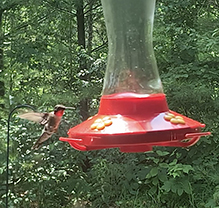 |
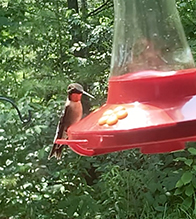 |
|
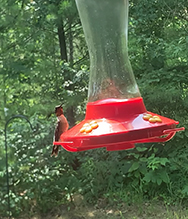 |
|
|
Gregory Gilman |
||
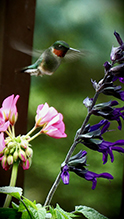 |
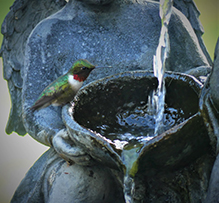 |
|
Male Hummer |
Male Ruby Throated Hummingbird |
|
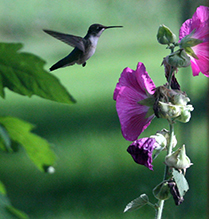 |
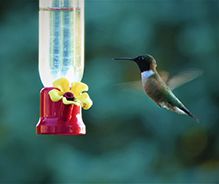 |
|
Female Ruby Throated Hummingbird |
||
Bobbi Johnson |
||
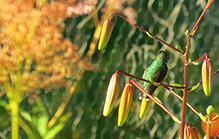 |
||
Hummingbird My husband and I call her Ball Breaker, since she's so adamant about scaring others out of the garden. lol |
||
Nagarjuna Basupalli |
||
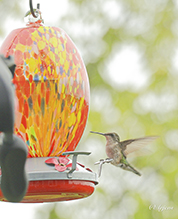 |
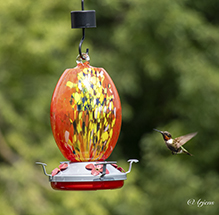 |
|
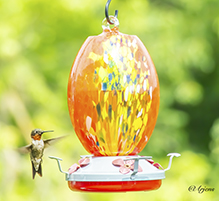 |
||
KG |
||
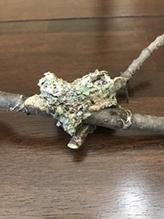 |
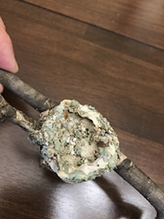 |
|
2019 hummingbird nest |
||
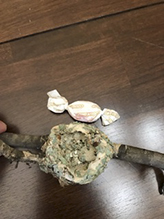 |
||
Gerry Garcia |
||
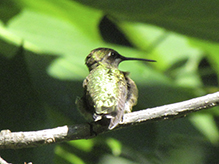 |
||
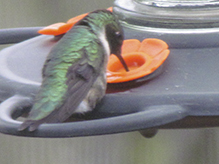 |
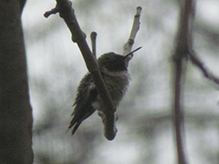 |
|
First Hummer of the year |
||
Laurie Wachholz |
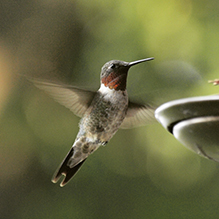 |
Brenda Johnson |
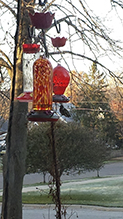 |
Bill Reynolds |
||
Female Ruby-throated Hummingbird taken in St Louis County I closely follow the spring and fall migration of the Ruby-throated Hummingbird each year. The first report of this season just came out. And so, with hummingbirds on the brain, I just noticed that you don't have any images of a Ruby-throated Hummingbird. These images are of Female Ruby-throated Hummingbird and were taken in St Louis County. |
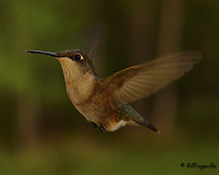 |
|
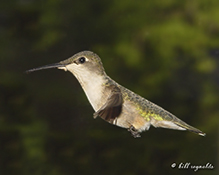 |
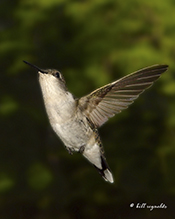
|
|
Each year I typically will have 8-10 hummingbird hanging around the property here in Pennington County.
|
||
Historically, the Ruby-throated arrives here in Minnesota near the end of April or early May each year and leave in September. |
||
MinnesotaSeasons.com Photos |
||
|
||
|
||

Slideshows |
Ruby-throated hummingbird |
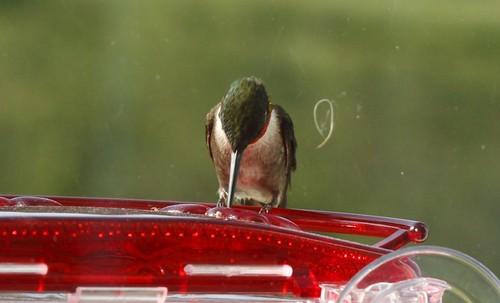
|
About
Archilochus colubris |
Ruby-throated Hummingbird |

|
Ruby-throated Hummingbird |
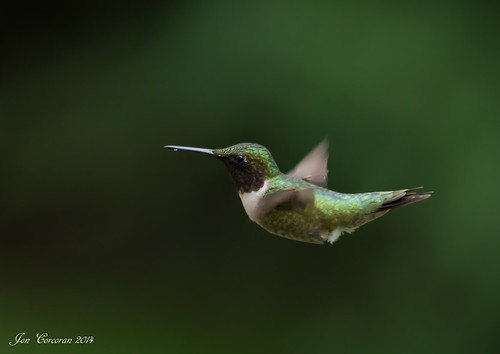
|

Visitor Videos |
||
Share your video of this bird. |
||
This button not working for you? |
||
Nagarjuna Basupalli |
Ruby throated Hummingbird 01 |
About
Ruby-throated Hummingbird (Archilochus colubris) Carver, MN 8/31/2023 Video by Nagarjuna Basupalli http://www.minnesotaseasons.com/Birds/Ruby-throated_Hummingbird.html |
Gerry Garcia |
Ruby throated Hummingbird 01 |
About
Ruby-throated Hummingbird (Archilochus colubris) Lyndale Park, Minneapolis, MN Video by Gerry Garcia http://www.minnesotaseasons.com/Birds/Ruby-throated_Hummingbird.html |
Ruby throated Hummingbird 02 |
About
Ruby-throated Hummingbird (Archilochus colubris) West Bloomington, MN Video by Gerry Garcia 9/26/2019 http://www.minnesotaseasons.com/Birds/Ruby-throated_Hummingbird.html |
Ruby throated Hummingbird 03 |
About
Ruby-throated Hummingbird (Archilochus colubris) West Bloomington, MN 9/26/2019 Video by Gerry Garcia http://www.minnesotaseasons.com/Birds/Ruby-throated_Hummingbird.html |
Other Videos |
||
Ruby-throated Hummingbird in Loring Park |
About
Published on Sep 2, 2013 Ruby-throated Hummingbird is stretching on the branch. |
Ruby Throated Hummingbird Archilochus Colubris 13 |
About
Published on Aug 8, 2013 No description available. |
Hungry male Ruby-throated hummingbird (Archilochus colubris) |
About
Published on Apr 22, 2013 Hungry male Ruby-throated hummingbird (Archilochus colubris). Transylvania County, NC. Shot 4/21/13 |

Visitor Sightings |
||
Report a sighting of this bird. |
||
This button not working for you? |
||
Lane Keller |
Location: Itasca State Park Many hummingbirds came by the visitor center and spent hours at the feeders today. |
 |
| Gregory Gilman 5/17/2025 |
Location: Rochester, MN Male Hummer |
Bobbi Johnson |
Location: Silver Bay, MN My husband and I call her Ball Breaker, since she's so adamant about scaring others out of the garden. lol |
 |
| Nagarjuna Basupalli 8/31/2023 |
Location: Carver, MN |
| Don in BC 11/23/2020 |
Location: Brooklyn Center, MN Activated my motion sensor on my surveillance camera |
|
| PikeMike 9/23/2020 |
Location: Big Lake, MN I had many all summer, they would empty a feeder in a day when all the young were flying. After the frosts they all left 9/21/2020. I miss them already. |
|
| Merrspa 9/7/2020 |
Location: Apple Valley, MN Such a special surprise to see this bird – I can’t remember the last time they came by my house! |
|
| Gregory Gilman 6/8/2020 |
Location: Rochester, MN |
| Gregory Gilman 5/29/2020 |
Location: Rochester, MN Male Ruby Throated Hummingbird |
| KG 9/22/2019 |
Location: Scott County 2019 hummingbird nest |
| Gerry Garcia 8/4/2019 |
Location: Lyndale Park, Minneapolis, MN |
| Gerry Garcia 5/6/2019 |
Location: West Bloomington First Hummer of the year |
| Brenda Johnson 10/24/2018 |
Location: Chatfield, MN How late in the fall will hummingbirds continue to migrate through southern Minnesota? |
|
| John Valo 10/27/2018 |
Southward migration begins in early August. According to Birds of Minnesota and Wisconsin (Janssen, Tessen, and Kennedy, 2003), Ruby-throated Hummingbird “rarely lingers into November.” |
|
| Lauren 10/14/2018 |
Location: Cannon Falls, MN I have 1 hummingbird left at my feeder. We got snow here today and freezing temperatures at night. I have been taking the feeder in at night and putting out every morning. Wish it would move on as I am worried about it. Anything else I can do to help? |
|
| Jeff Larson 10/14/2018 |
Location: southern Minnesota I have a hummingbird on my feeder today does it need rescue? |
|
| Charles Ham 9/28/2017 |
Location: Minnetonka Our Ruby Throated Hummingbirds departed on Sept. 27. We had two families coming to our feeder on the 26th and none on the 27th. |
|
| Bill Reynolds 5/27/2006 |
Location: St. Louis County I closely follow the spring and fall migration of the Ruby-throated Hummingbird each year. The first report of this season just came out. And so, with hummingbirds on the brain, I just noticed that you don't have any images of a Ruby-throated Hummingbird. |
|
These images are of Female Ruby-throated Hummingbird and were taken in St Louis County. Each year I typically will have 8-10 hummingbird hanging around the property here in Pennington County. Historically, the Ruby-throated arrives here in Minnesota near the end of April or early May each year and leave in September. |
||
MinnesotaSeasons.com Sightings |
||

|
Created: 6/26/2009 Last Updated: © MinnesotaSeasons.com. All rights reserved. |









